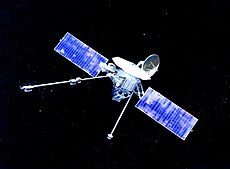Venera 3, a Soviet unmanned space probe, crash landed on the surface of Venus in 1966. It was launched on November 16, 1965. It was the first man-made object to travel to another planet.

Mariner 10
Mariner 10 flew by Mercury for the first time in 1974. Launched November 3, 1973, it first flew by Venus on February 5, 1974. After it flew by Mercury, it orbited the sun and came close to Mercury again on September 21, 1974. A third encounter happened on March 16, 1975. Data from Mariner 10 included 2,800 photographs of Mercury as well as information on a helium atmosphere and an iron-rich core. Mariner 10 ran out of fuel and stopped transmitting data on March 24, 1975. Scientists believe that it continues to orbit the sun. Children could learn more at: Mariner 10.

Magellan fixed inside Atlantis
Atlantis, an American shuttle spacecraft, was launched in 1989. It successfully deployed Magellan, which traveled to Venus to map the planet’s surface. Magellan encountered Venus on August 10, 1990 and began taking high-quality radar images on September 15, 1990. It continued to photograph the planet’s surface, making six complete mapping cycles. Magellan mapped about 98 percent of Venus’s surface. It was commanded to plunge into Venus’s surface, still sending data, on October 13, 1994. Children could learn more at: Magellan.
Venera 3, a Soviet unmanned space probe, was launched in 1965. It crash landed on the surface of Venus on March 1, 1966. It was the first man-made object to travel to another planet. Children could figure out how many days it took to get to Venus and the distance it traveled. They could make various math problems from those statistics.
Vega I was launched by the Soviet Union in 1984. It dropped scientific balloons into the atmosphere of Venus on June 11, 1985, and then made contact with Halley’s Comet in March of 1986. It took many images of the comet and studied the comet’s nucleus and coma. Now Vega I circles the sun. Older children can learn more at: Vega I.